上海交通大学:《美国公共政策制定 Public Policy-making in the U.S.》课程教学资源(PPT课件)04 The Policy-Making Process
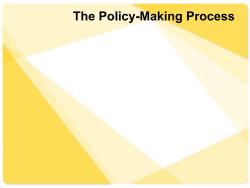
The Policy-Making Process
The Policy-Making Process
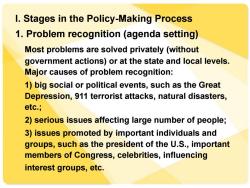
I.Stages in the Policy-Making Process 1.Problem recognition (agenda setting) Most problems are solved privately (without government actions)or at the state and local levels. Major causes of problem recognition: 1)big social or political events,such as the Great Depression,911 terrorist attacks,natural disasters, etc.; 2)serious issues affecting large number of people; 3)issues promoted by important individuals and groups,such as the president of the U.S.,important members of Congress,celebrities,influencing interest groups,etc
I. Stages in the Policy-Making Process 1. Problem recognition (agenda setting) Most problems are solved privately (without government actions) or at the state and local levels. Major causes of problem recognition: 1) big social or political events, such as the Great Depression, 911 terrorist attacks, natural disasters, etc.; 2) serious issues affecting large number of people; 3) issues promoted by important individuals and groups, such as the president of the U.S., important members of Congress, celebrities, influencing interest groups, etc
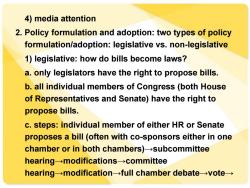
4)media attention 2.Policy formulation and adoption:two types of policy formulation/adoption:legislative vs.non-legislative 1)legislative:how do bills become laws? a.only legislators have the right to propose bills. b.all individual members of Congress (both House of Representatives and Senate)have the right to propose bills. c.steps:individual member of either HR or Senate proposes a bill(often with co-sponsors either in one chamber or in both chambers)-subcommittee hearing→nodifications→committee hearing→modification→full chamber debatevote→
4) media attention 2. Policy formulation and adoption: two types of policy formulation/adoption: legislative vs. non-legislative 1) legislative: how do bills become laws? a. only legislators have the right to propose bills. b. all individual members of Congress (both House of Representatives and Senate) have the right to propose bills. c. steps: individual member of either HR or Senate proposes a bill (often with co-sponsors either in one chamber or in both chambers)→subcommittee hearing→modifications→committee hearing→modification→full chamber debate→vote→
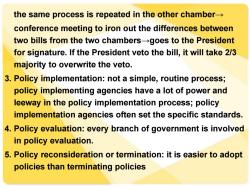
the same process is repeated in the other chamber conference meeting to iron out the differences between two bills from the two chambers-goes to the President for signature.If the President veto the bill,it will take 2/3 majority to overwrite the veto. 3.Policy implementation:not a simple,routine process; policy implementing agencies have a lot of power and leeway in the policy implementation process;policy implementation agencies often set the specific standards. 4.Policy evaluation:every branch of government is involved in policy evaluation. 5.Policy reconsideration or termination:it is easier to adopt policies than terminating policies
the same process is repeated in the other chamber→ conference meeting to iron out the differences between two bills from the two chambers→goes to the President for signature. If the President veto the bill, it will take 2/3 majority to overwrite the veto. 3. Policy implementation: not a simple, routine process; policy implementing agencies have a lot of power and leeway in the policy implementation process; policy implementation agencies often set the specific standards. 4. Policy evaluation: every branch of government is involved in policy evaluation. 5. Policy reconsideration or termination: it is easier to adopt policies than terminating policies

2)non-legislative:bureaucratic regulations; presidential executive orders,controversial,does not have clear constitutional basis,Congress tried to override presidential executive order between 1939-83 when the court determined that Congress does not have such power.Presidential executive orders can be tested by court,but the court rarely challenges the president's authority in issuing presidential executive orders.The president should be careful in issuing presidential executive orders
2) non-legislative: bureaucratic regulations; presidential executive orders, controversial, does not have clear constitutional basis, Congress tried to override presidential executive order between 1939-83 when the court determined that Congress does not have such power. Presidential executive orders can be tested by court, but the court rarely challenges the president's authority in issuing presidential executive orders. The president should be careful in issuing presidential executive orders
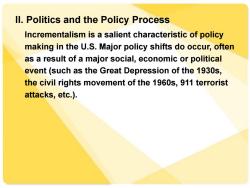
Il.Politics and the Policy Process Incrementalism is a salient characteristic of policy making in the U.S.Major policy shifts do occur,often as a result of a major social,economic or political event(such as the Great Depression of the 1930s, the civil rights movement of the 1960s,911 terrorist attacks,etc.)
II. Politics and the Policy Process Incrementalism is a salient characteristic of policy making in the U.S. Major policy shifts do occur, often as a result of a major social, economic or political event (such as the Great Depression of the 1930s, the civil rights movement of the 1960s, 911 terrorist attacks, etc.)
按次数下载不扣除下载券;
注册用户24小时内重复下载只扣除一次;
顺序:VIP每日次数-->可用次数-->下载券;
- 上海交通大学:《美国公共政策制定 Public Policy-making in the U.S.》课程教学资源(PPT课件)03 Public Policy Contents.ppt
- 上海交通大学:《美国公共政策制定 Public Policy-making in the U.S.》课程教学资源(PPT课件)02 Cultural, Historical and Political Background of Public Policy-making in the U.S..ppt
- 上海交通大学:《美国公共政策制定 Public Policy-making in the U.S.》课程教学资源(PPT课件)11 U.S. Foreign Economic Policy Making.ppt
- 上海交通大学:《美国公共政策制定 Public Policy-making in the U.S.》课程教学资源(PPT课件)10 Foreign and Defense Policy-Making in the United States.ppt
- 上海交通大学:《美国公共政策制定 Public Policy-making in the U.S.》课程教学资源(PPT课件)01 An Introduction(钟杨).ppt
- 上海交通大学:《美国公共政策制定 Public Policy-making in the U.S.》课程教学资源(讲义)Chapters 4, 16-20.pdf
- 上海交通大学:《美国公共政策制定 Public Policy-making in the U.S.》课程教学资源(讲义)Chapters 20-23.pdf
- 上海交通大学:《美国公共政策制定 Public Policy-making in the U.S.》课程教学资源(讲义)Chapter 7 EQUAL RIGHTS:STRUGGLING TOWARD EAIRNESS.pdf
- 上海交通大学:《美国公共政策制定 Public Policy-making in the U.S.》课程教学资源(讲义)Chapter 6 ECONOMIC RIGHTS AND OPPORTUNITIES:EXPRESSING INDIVIDUALISM.pdf
- 上海交通大学:《美国公共政策制定 Public Policy-making in the U.S.》课程教学资源(讲义)Chapter 5 CIVIL LIBERTIES:PROTECTING INDIVIDUAL RIGHTS.pdf
- 上海交通大学:《美国公共政策制定 Public Policy-making in the U.S.》课程教学资源(讲义)Chapter 3 LIMITED GOVERNMENT:PRESERVING LIBERTY.pdf
- 上海交通大学:《现代日本政治 Contemporary Japanese Politics》课程教学资源(课程讲义,共十章).doc
- 上海交通大学:《现代日本政治 Contemporary Japanese Politics》课程PPT教学课件(翟新,共九章).ppt
- 上海交通大学:《现代日本政治 Contemporary Japanese Politics》课程教学资源(参考资料)日華平和条約.pdf
- 上海交通大学:《现代日本政治 Contemporary Japanese Politics》课程教学资源(参考资料)日本自民党政权修宪的政治动向.pptx
- 上海交通大学:《现代日本政治 Contemporary Japanese Politics》课程教学资源(参考资料)日本政治史年表.pdf
- 上海交通大学:《现代日本政治 Contemporary Japanese Politics》课程教学资源(参考资料)日本政府关于历史问题正式见解.doc
- 上海交通大学:《现代日本政治 Contemporary Japanese Politics》课程教学资源(参考资料)日本国宪法.pdf
- 上海交通大学:《现代日本政治 Contemporary Japanese Politics》课程教学资源(参考资料)戰後日本的兩個中國政策與台灣觀.pdf
- 上海交通大学:《现代日本政治 Contemporary Japanese Politics》课程教学资源(参考资料)周鸿庆事件.pdf
- 上海交通大学:《美国公共政策制定 Public Policy-making in the U.S.》课程教学资源(PPT课件)05 The Role of the Executive Branch in the Policy-Making Process.ppt
- 上海交通大学:《美国公共政策制定 Public Policy-making in the U.S.》课程教学资源(PPT课件)06 The Role of the Legislative Branch in the Policy-Making Process.ppt
- 上海交通大学:《美国公共政策制定 Public Policy-making in the U.S.》课程教学资源(PPT课件)07 The Role of the Judicial Branch in the Policy-Making Process.ppt
- 上海交通大学:《美国公共政策制定 Public Policy-making in the U.S.》课程教学资源(PPT课件)08 Political Parties, Campaigns and Elections in the U.S..ppt
- 上海交通大学:《美国公共政策制定 Public Policy-making in the U.S.》课程教学资源(PPT课件)09 Public Participation in the Policy-Making Process in the United States.ppt
- 上海交通大学:《美国公共政策制定 Public Policy-making in the U.S.》课程教学资源(讲义)CHAPTER 28 NATIONAL SECURITY POLICY.pdf
- 上海交通大学:《美国公共政策制定 Public Policy-making in the U.S.》课程教学资源(讲义)Chapters 24-25.pdf
- 上海交通大学:《美国公共政策制定 Public Policy-making in the U.S.》课程教学资源(讲义)Chapters 11-12.pdf
- 上海交通大学:《美国公共政策制定 Public Policy-making in the U.S.》课程教学资源(讲义)Chapters 13-15.pdf
- 上海交通大学:《美国公共政策制定 Public Policy-making in the U.S.》课程教学资源(作业展示)The U.S Government Shutdown of 2013.docx
- 上海交通大学:《美国公共政策制定 Public Policy-making in the U.S.》课程教学资源(作业展示)The Government Shutdown.doc
- 上海交通大学:《美国公共政策制定 Public Policy-making in the U.S.》课程教学资源(作业展示)American government shut down.doc
- 上海交通大学:《美国公共政策制定 Public Policy-making in the U.S.》课程教学资源(作业展示)My Understanding Of US Government Shutdown at 2013.docx
- 上海交通大学:《美国宪法与美国社会》课程教学资源_历史文献_艰难的一跃(美国宪法的诞生和我们的反思).pdf
- 山东大学法学院:必读之书——谈谈美国宪法理论经典(田雷).pdf
- 上海交通大学:《美国宪法与美国社会》课程教学资源_学术论文_电影《阿甘正传》与美国社会的价值回归.pdf
- 上海交通大学:《美国宪法与美国社会》课程教学资源_学术论文_美国宪法解释方法之要素分析(范进学).pdf
- 上海交通大学:《美国宪法与美国社会》课程教学资源_学术论文_美国法院如何遵循先例(林彦).pdf
- 《社会科学家》:美国社会的法律与性别一种法社会学分析(西华师范大学:青维富).pdf
- 上海交通大学:《美国宪法与美国社会》课程教学资源_相关案例_美国诉尼克松案 United States v. Nixon.doc
